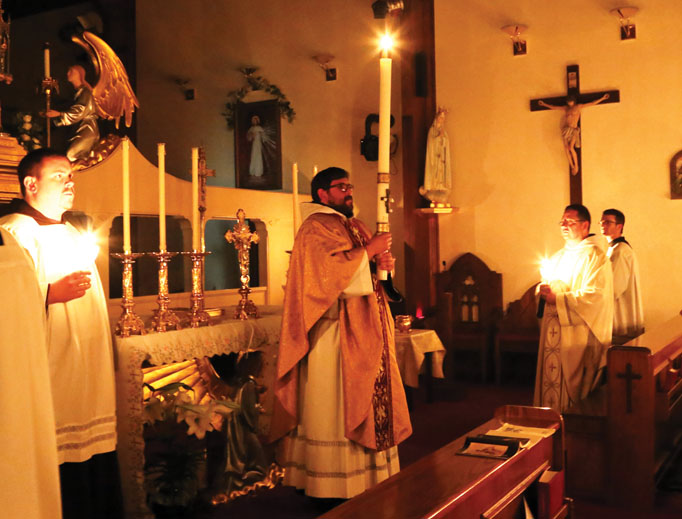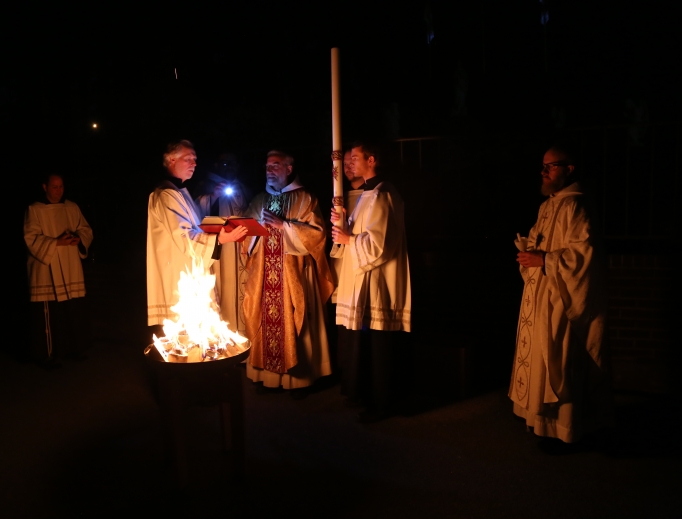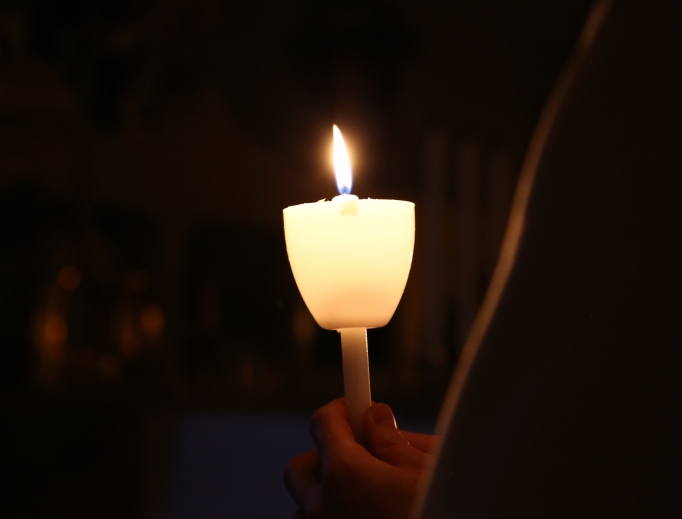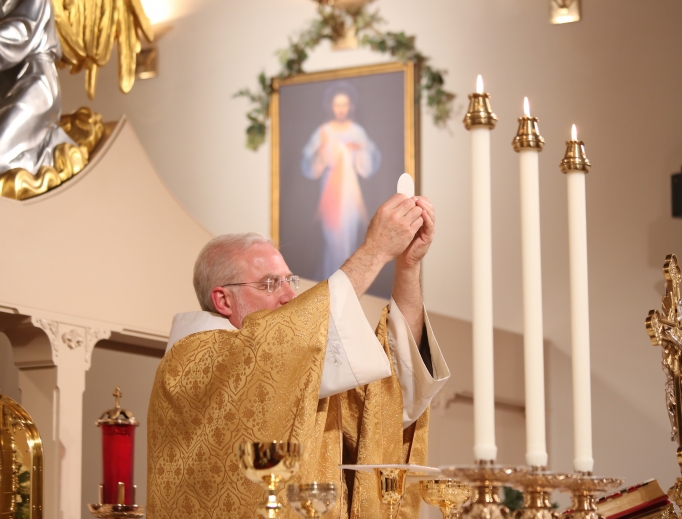The Easter Vigil Sheds Light — Ever Ancient, Ever New — on the Pascal Celebration
‘Mother of All Holy Vigils’ symbolizes new life in Christ.

A 2015 Harris Poll on the popularity of holidays found that only 3% of the general population ranked Easter as their favorite, while Christmas had the top spot in the poll, with 46% in favor.
In one of his published homilies, Msgr. Robert Hundt of the Diocese of La Crosse, Wisconsin, sought to understand this disparity between the two major Christian holidays: “My guess is that a lot of people think they understand the birth of a child, shepherds, mother, father, stable and animals, while very few think they can warm up to an empty tomb, frightened women and a certified dead man sitting down at a table and eating with his friends.”
Yet the celebration of the Easter season is anything but the cold abstraction of “an empty tomb,” as Easter’s first liturgical celebration, the Easter vigil, can attest. As the first Mass of Easter, the vigil is celebrated around the world, after nightfall and before daybreak, as the high point of the three-day Easter Triduum, which also includes the Holy Thursday evening Mass of the Lord’s Supper and the Good Friday liturgy. (On Holy Saturday, a day set apart from the rest of the liturgical year, because it commemorates Christ in the tomb, the Church abstains from celebrating Mass or giving Communion except as viaticum, which is final Communion to a dying person.)
While distinct from Lent, the Easter Triduum serves as both the grand finale to the Lenten season and a resounding overture to the approaching Easter season, and as anyone who has participated in the Easter vigil, the “mother of all holy vigils” (as St. Augustine once called the Easter vigil in a sermon), knows, the Easter vigil is crammed full of concrete and engaging liturgical symbolism, easily rivaling Christmas midnight Mass as one of the Church’s most dramatic and joyous celebrations.
Like the Church itself, the Easter vigil is ever ancient and ever new. While the Easter vigil celebrated today is a relative newcomer in the Church’s current liturgical calendar, this same celebration finds its first expression in the earliest days of the Church.
In 1955, Pope Pius XII resurrected the ancient rites of the Triduum, including the Easter vigil, restoring it to its pride of place among the Church’s many liturgical celebrations. In so doing, as the Register reported at the time, the Pope renewed how the Church celebrates Easter.
Today, pastors continue to find the Easter vigil a source of spiritual renewal for their flocks as they gather around the Easter fire that ignites this liturgy — and the world — with new life in Christ.
In a reversal of Passion Week, which steadily draws the faithful toward the darkness at noon on Calvary, the Easter vigil begins in darkness because, as the Vatican’s 1988 liturgical document on the celebration of the Easter feasts, Paschales Solemnitatis, notes, during this liturgy, “the Church keeps vigil, waiting for the resurrection of the Lord, and celebrates the sacraments of Christian initiation.”
Thus, step by step, throughout its celebration, the Easter vigil moves into light.
“The Easter vigil consists of four main parts,” said Christopher Carstens, editor of the liturgical journal Adoremus Bulletin and the director of the Office of Sacred Liturgy for the Diocese of La Crosse. “The blessing of the fire and candle, followed by the procession into the church and the singing of the Exsultet; the Liturgy of the Word, which, over the course of many readings, recounts God’s saving works in salvation history; the initiation of new members into the Church through baptism and confirmation; and the celebration of the Eucharist, which is the substantial re-presentation of Christ’s saving paschal mystery: In each case, the rites and sacramental signs manifest the resurrected Jesus, the new light, the new life and his new creation.”


This movement from darkness to light, Carstens told the Register, is both a reminder of Christ’s salvific action in the moment of his resurrection but also a replay of salvation history.
“The enslaved Israelites were the first to keep vigil for the Lord during their last night in Egypt,” Carstens said. “Now, at the definitive exodus and Passover, Christ’s new people — like vigilant ‘servants who await their master’s return’ (Luke 12:35-37) — watch for the Lord during the night, only to find him illuminating the darkness with new and brilliant fire and light.”
History and Mystery
The front page of the Jan. 22, 1955, issue of the Register reported the first indications that Pius XII was going to institute changes to the Easter liturgy: “A special decree of the Sacred Congregation of Rites extends to the bishops for another year the privilege of transferring the Holy Saturday Liturgy to the evening hours of the same day.” As the article notes, this privilege was first granted to bishops in 1951 “as an experiment” and extended in 1952 for three more years.
By year’s end, G.R. Brunet wrote in the Dec. 4, 1955, issue of the Register, Pius XII was preparing to hand out a profoundly significant gift to the Church: “A new ‘Holy Week Ordo,’ which will be issued within a few days, will go into force on Palm Sunday, 1956.”
The new Ordo, Brunet wrote, heralded “[f]ar-reaching changes in the entire Holy Week Liturgy, involving Palm Sunday, Holy Thursday, Good Friday and Holy Saturday,” as “decreed by the Sacred Congregation of Rites.”
Brunet noted that, originally, the Church had celebrated the Easter vigil in the evening in keeping with the time that the historical events they celebrated took place; but there had been a slow but steady drift toward celebrating the Triduum in the morning hours.
In a 1961 Register column, Jesuit Father William Quiery put the Easter vigil in its proper historical context, explaining that 300 years before Christmas became a major celebration, “Easter was the only feast which was celebrated throughout the whole Church. The earliest date that historians have been able to discover for the celebration of Christmas is about the year 336. But Easter was a feast in the Church from the very start.”
Fittingly, those early Easter celebrations began, Father Quiery noted, in darkness. “In the first centuries the Easter Mass was invariably at night — because it was during the night leading into Easter Sunday that Jesus rose from the dead.”
In fact, when Emperor Constantine became the first Christian leader of the Roman Empire, the Easter vigil inspired a celebration of lights throughout the entire Eternal City.
“At [Constantine’s] command,” Father Quiery wrote, “the whole city of Rome was kept aglow that night with the fire of thousands of torches.”
Brunet also noted that Pius XII restored the Easter vigil as an evening celebration for pastoral reasons, responding to the requests of “bishops and liturgists” to restore the ancient liturgy.
And they had the numbers to support their requests, as the Register reported that, by February 1953, “more than 1,000 churches and chapels in the United States and Canada observed the new rite in 1952,” and three dioceses even announced that the revised Easter vigil liturgy was to become mandatory. Pius XII heeded these requests and established a commission to study “the possibility of a reform” in the Holy Week liturgies. The Holy Week Ordo is the culmination of that study.
By 1965, in the April 8 issue, the Register was reporting that the Easter vigil had become a regular feature of Holy Week celebrations. Pius XII’s restoration was complete. The Easter vigil was universally recognized as “the most solemn memorial, in the entire year, of the central mystery of our redemption: Christ’s saving death and glorious resurrection.”
Light and Warmth
Father William Felix, the pastor of All Saints parish in Stanley, Wisconsin, said that many in his parish of 825 households are drawn to these same added levels of mystery in the Easter vigil.
“First of all,” he told the Register, “when the faithful come to the Easter vigil, and the fire is lit outside the church, it conjures up all kinds of things for them. The darkness gives way to light and warmth.”
Holy Family is located in north-central Wisconsin, and, according to Father Felix, the weather is “hit-or-miss,” either seasonably mild around Eastertime, or, occasionally, “very, very cold,” and his flock tend to huddle closer to the Easter fire the lower the mercury drops. “In this way, the Easter fire can have some practical aspects, too.”
No single moment defines the Easter vigil when Father Felix celebrates it for his parish. But, Father Felix said, the faithful become aware of the liturgy’s power with a series of moments in transition, “from all of the darkness that has been present in the liturgy up until the point of the Gloria, which has not been sung — except maybe during a solemnity or two during Lent — since before Ash Wednesday.”
“That’s when the lights in the church are turned on, the candles are lit, and from that point on, there is a marked transition from darkness to the light, which ultimately leads to a celebration of the Eucharist,” he added. “The final powerful sign is when the Blessed Sacrament, which has been removed after Holy Thursday and is not in the church, is reposed back into the tabernacle at the same time that the sanctuary light is relit.”

Register correspondent Joseph O’Brien writes from Soldiers Grove, Wisconsin.
- Keywords:
- easter
- easter vigil
- joseph o’brien

















